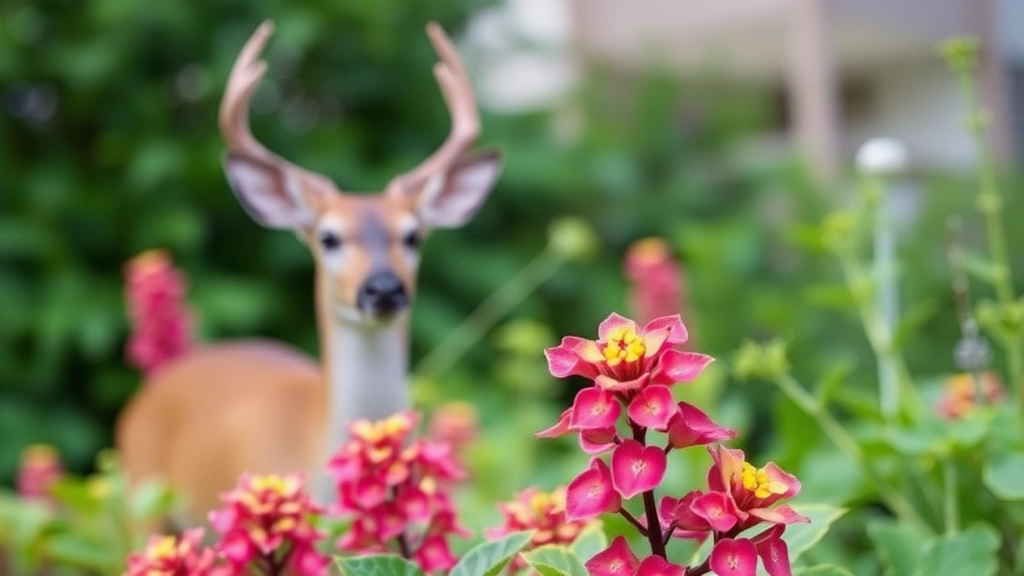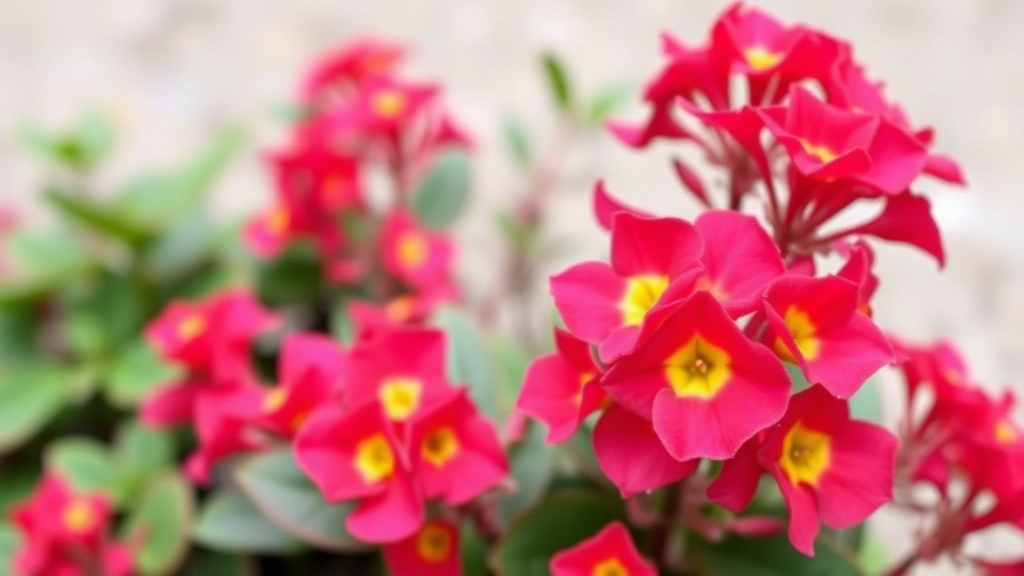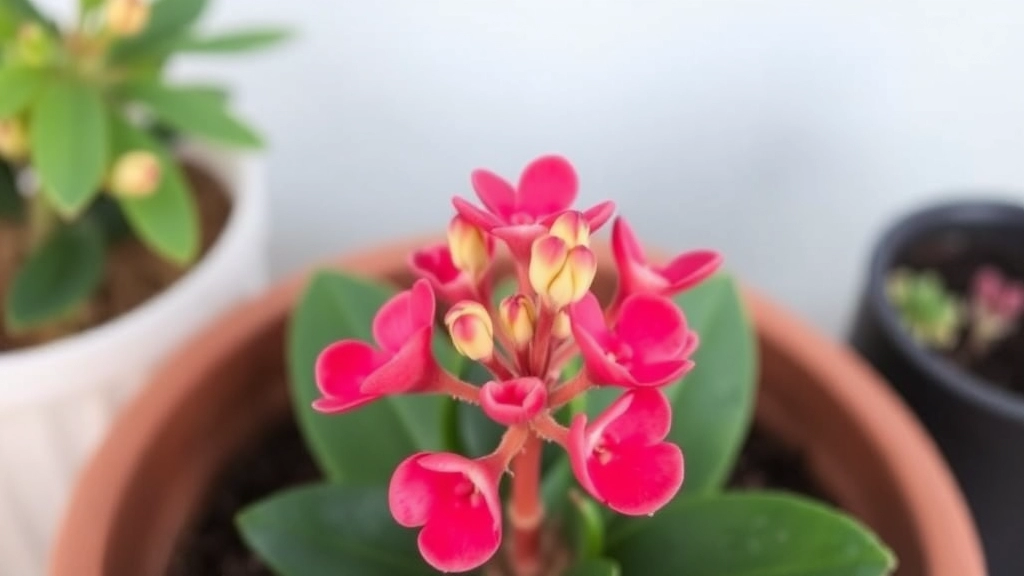Do Deer Eat Kalanchoe?
Wondering if deer munch on Kalanchoe? Typically, deer avoid Kalanchoe plants due to their bitter taste and toxic compounds, making them less appealing compared to other garden plants. However, during times of food scarcity, such as winter or drought, deer might still take a nibble, potentially causing some damage.
Protecting Your Kalanchoe
Understanding the factors that affect deer feeding habits can help you protect your Kalanchoe. Companion planting and physical barriers are effective strategies to keep these curious grazers at bay. By taking these steps, you can ensure your vibrant Kalanchoe plants remain safe and thriving.
Why Deer Typically Avoid Kalanchoe
Have you ever wondered why deer tend to steer clear of Kalanchoe plants? This intriguing behaviour can be attributed to several factors that make Kalanchoe less appealing to these herbivores.
Firstly, Kalanchoe is known for its bitter taste. This natural defence mechanism is often enough to deter deer, as they instinctively avoid plants that may be harmful or unpalatable.
Additionally, Kalanchoe contains toxic compounds that can cause discomfort or illness in deer. While these compounds can vary between different species of Kalanchoe, their presence generally contributes to the plant’s overall unattractiveness.
Moreover, deer are opportunistic feeders. They tend to choose plants that are easy to digest and provide maximum nutrition. Kalanchoe, with its thick, fleshy leaves, does not fit this profile.
- Bitter Taste: A natural deterrent.
- Toxic Compounds: Potentially harmful to deer.
- Low Nutritional Value: Not an ideal food source.
In summary, the combination of taste, toxicity, and nutritional content makes Kalanchoe an unappealing choice for deer. For more information on how to care for these resilient plants, check out our comprehensive Kalanchoe plant care guide and learn about the different Kalanchoe species for your garden.
Factors That May Encourage Deer to Eat Kalanchoe

So, we’ve talked about why deer generally avoid Kalanchoe. But what makes them consider munching on these succulent beauties? Let’s dive into some key factors that might turn them into unexpected fans of Kalanchoe.
1. Food Shortages
When food is scarce, deer may become more adventurous in their eating habits.
- Seasonal Changes: During winter or droughts, their usual food sources might dwindle, pushing them to explore alternative options.
- Overpopulation: In areas where deer populations are high, they may be forced to nibble on plants they’d typically ignore.
2. Hunger and Nutritional Needs
Deer are creatures of habit, but when hunger strikes, they can be quite opportunistic.
- Nutritional Deficiencies: If their diet lacks certain nutrients, they might turn to Kalanchoe as a source of hydration and vitamins.
- Curiosity: Sometimes, they might just be curious about a new plant in their territory.
3. Stress Factors
Stress can lead deer to change their eating behaviour.
- Predator Presence: If they feel threatened by predators, they may venture closer to gardens where Kalanchoe grows, especially if it offers a quick snack.
- Human Activity: Increased human presence can disrupt their usual feeding patterns, making them more desperate for food.
4. Plant Health and Condition
Believe it or not, the condition of your Kalanchoe can play a role too.
- Neglected Plants: If your plants are unhealthy or wilting, they might emit different scents that attract deer.
- Fresh Growth: New growth can be particularly enticing, as it often has a different texture and moisture content.
5. Location
The setting of your garden can influence deer behaviour.
- Proximity to Wooded Areas: If your Kalanchoe is near woods or natural deer paths, it’s more likely to catch their eye.
- Visibility: Open areas make it easier for deer to spot your plants, increasing the chances of them taking a bite.
Many gardeners often wonder why deer tend to steer clear of certain plants, including Kalanchoe. One significant factor is the plant’s bitter taste, which acts as a natural deterrent.
Kalanchoe contains compounds that produce a distinctly unpalatable flavour. This bitterness is a key reason why deer typically avoid munching on these succulent plants.
Here are some insights into how this works:
– **Chemical Compounds**: Kalanchoe is rich in secondary metabolites, which contribute to its bitter taste. These compounds can be toxic or simply unpleasant to herbivores.
– **Instinctual Behaviour**: Deer have evolved to avoid plants that taste bitter or toxic. This instinct helps them survive by steering clear of potentially harmful food sources.
– **Taste Sensitivity**: Deer possess a keen sense of taste and are quick to recognise unpalatable plants. Once they experience Kalanchoe’s bitterness, they are likely to remember and avoid it in the future.
Understanding the role of Kalanchoe’s bitter taste provides valuable insight into why these plants are often left untouched by deer. For more tips on growing and caring for Kalanchoe, check out the [complete guide to growing Kalanchoe Mother of Thousands](https://planthq.org/complete-guide-to-growing-kalanchoe-mother-of-thousands/) and learn about the [care and propagation of Kalanchoe Mother of Millions](https://planthq.org/how-to-care-for-and-propagate-kalanchoe-mother-of-millions/).
Protecting Kalanchoe from Deer During Food Shortages

As we delve into the strategies for safeguarding Kalanchoe, it’s essential to consider the times when deer are most likely to venture into our gardens. During food shortages, deer may become desperate and more inclined to nibble on plants they typically avoid.
Understanding Food Shortages
Deer often face food scarcity during late winter or drought periods. In these times, they may turn to less preferred plants, including Kalanchoe. To protect your beloved Kalanchoe during these challenging periods, consider the following strategies:
- Create a Barrier: Use fencing or netting to shield your plants. A fence should be at least 8 feet tall to deter deer effectively.
- Utilise Repellents: Apply deer repellents that are commercially available or homemade sprays. Ingredients like garlic or hot pepper can deter deer due to their strong scents.
- Plant Diversion: Introduce plants that deer find more appealing around your Kalanchoe. This can draw their attention away from your prized succulents.
- Regular Monitoring: Keep an eye on your garden. Spotting deer early can help you implement protective measures promptly.
- Mulching: Use mulch to create a less inviting environment around Kalanchoe. Certain types of mulch, like pine needles, can deter deer.
By employing these methods, you can significantly reduce the risk of deer munching on your Kalanchoe during food shortages.
The Importance of Companion Planting to Deter Deer
As we explore effective strategies for protecting Kalanchoe from deer, it’s essential to consider the role of companion planting. This method not only enhances the health of your garden but can also discourage deer from feasting on your prized plants.
Why Companion Planting Works
Companion planting involves growing different plants in proximity for mutual benefits. When it comes to deterring deer, certain plants can act as natural repellents. Here are some effective strategies:
- Strong Scents: Plants like lavender, rosemary, and mint emit strong fragrances that deer find unappealing. Incorporating these around your Kalanchoe can create a natural barrier.
- Bitter Tastes: Some herbs, such as sage and thyme, have a bitter taste that can deter deer. Planting these alongside Kalanchoe may help protect them.
- Visual Disruption: Tall or bushy plants can obscure the view of Kalanchoe, making it less noticeable to deer. Consider adding ornamental grasses or sunflowers to create a visual shield.
Practical Examples
Imagine a garden where Kalanchoe thrives among fragrant herbs and vibrant flowers. The scent of lavender mingles with the sight of tall sunflowers, creating an inviting yet unwelcoming environment for deer.
Moreover, I’ve seen gardeners successfully use this method, reporting less deer damage and healthier plants. It’s a simple yet effective way to enhance your garden’s biodiversity while keeping deer at bay. For more tips on growing healthy Kalanchoe, check out our top Kalanchoe succulent varieties and care tips and learn about the medicinal benefits of Kalanchoe Pinnata.
Effective Use of Physical Barriers for Kalanchoe Protection

So, you’ve got your Kalanchoe all set up, but what if those pesky deer come knocking?
Using physical barriers can be a game-changer in keeping your plants safe.
Here’s how you can effectively protect your Kalanchoe:
- Fencing: A sturdy fence is one of the best ways to keep deer out. Aim for at least 6 to 8 feet high. Deer can jump, so don’t skimp on the height!
- Netting: If you’re looking for something less permanent, garden netting can work wonders. Drape it over your Kalanchoe to create a protective layer without obstructing sunlight.
- Row Covers: Lightweight row covers not only protect your plants from deer but also from harsh weather. They’re easy to set up and can be removed when not needed.
- Garden Stakes: Use stakes to hold up netting or row covers, ensuring they stay in place and don’t sag. This keeps deer from easily accessing your plants.
- Motion Sensors: Consider adding motion-activated sprinklers or noise devices. The sudden movement or sound can startle deer and send them packing.
- Mulch Barriers: A thick layer of mulch around your Kalanchoe can deter deer by making it harder for them to access the roots.
Remember, combining these methods often yields the best results.
For instance, a fence paired with netting can create a double layer of security.
Not only do these barriers protect your Kalanchoe, but they also add an aesthetic touch to your garden.
Common Deer-Resistant Kalanchoe Varieties
As we explore the various factors that influence deer behaviour, it’s essential to identify specific Kalanchoe varieties that tend to resist deer foraging.
1. Kalanchoe tomentosa (Panda Plant)
This variety is characterised by its fuzzy, silvery leaves, which deer often find unappealing.
- Bitter Taste: The leaves have a mild bitterness that deters many herbivores.
- Care Tips: Prefers bright light and well-drained soil. For more details, check out this complete guide to Kalanchoe Panda Plant care.
2. Kalanchoe blossfeldiana (Flaming Katy)
With its vibrant blooms, this Kalanchoe is not only visually appealing but also less favoured by deer.
- Tough Texture: The thicker leaves make it less palatable.
- Care Tips: Thrives in indirect sunlight and requires minimal watering. Learn more in our Flaming Katy care guide.
3. Kalanchoe luciae (Paddle Plant)
This succulent boasts large, paddle-shaped leaves that are often overlooked by deer.
- Water Storage: Its ability to store water makes it resilient and less attractive during dry spells.
- Care Tips: Enjoys full sun and can tolerate drought conditions.
4. Kalanchoe fedtschenkoi (Chandelier Plant)
Known for its cascading growth, this variety is also a deer-resistant option.
- Aromatic Leaves: The strong scent may deter deer and other pests.
- Care Tips: Prefers bright light and can grow in various soil types.
5. Kalanchoe beharensis (Felt Plant)
With its unique texture and size, this variety is not typically targeted by deer.
- Robust Structure: Its thick, felt-like leaves are less appealing for browsing.
- Care Tips: Requires ample sunlight and infrequent watering.
By selecting these deer-resistant Kalanchoe varieties, you can enhance your garden’s resilience against deer while enjoying their beauty.
Impact of Climate and Location on Deer Attraction
Have you ever wondered why some gardens seem to attract deer like a magnet, while others remain untouched?
The climate and location of your garden play a significant role in whether deer decide to munch on your Kalanchoe or leave it alone.
Climate Considerations:
- Temperature: In warmer climates, deer may have more food options available, making them less likely to nibble on Kalanchoe.
- Season: During winter or food shortages, deer might venture into gardens searching for anything green, including your beloved plants.
- Rainfall: Areas with heavy rainfall can lead to lush vegetation, giving deer plenty of choices and potentially steering them away from Kalanchoe.
Location Factors:
- Urban vs. Rural: Urban areas often have more human activity, which can deter deer. In contrast, rural gardens may be more prone to deer visits.
- Proximity to Woodlands: If your garden is near forests or wooded areas, deer are more likely to roam through, increasing the chance of them spotting your Kalanchoe.
Personal Experience:
I’ve noticed that in my own garden, which sits close to a wooded area, I’ve had to be extra vigilant during autumn when food becomes scarce.
Deer seem to be more curious and willing to explore.
In contrast, my friend who lives in a bustling city has had no issues with deer at all.
This just goes to show how climate and location can truly influence deer behaviour.
If you’re looking to protect your plants, especially during challenging seasons, consider reading our postbloom Kalanchoe care guide for expert tips on maintaining plant health. Additionally, for those in urban settings, our Kalanchoe Blossfeldiana indoor vs. outdoor care guide could offer valuable insights.
FAQs on Deer and Kalanchoe
Do deer eat Kalanchoe?
Generally, deer avoid Kalanchoe due to its bitter taste and toxic properties. However, in certain circumstances, they might consider eating it.
What factors might encourage deer to eat Kalanchoe?
Several factors can make deer more likely to nibble on Kalanchoe, including:
- Food Shortages: Seasonal changes or overpopulation can lead to scarce food supplies.
- Hunger and Nutritional Needs: Nutritional deficiencies or curiosity can drive them to try new plants.
- Stress Factors: Predator presence or increased human activity can alter their eating habits.
- Plant Health and Condition: Unhealthy or fresh growth plants might attract deer.
- Location: Proximity to wooded areas and visibility can influence deer behavior.
How can I protect my Kalanchoe from deer during food shortages?
During times of food scarcity, deer are more likely to venture into gardens. To protect your Kalanchoe, consider these strategies:
- Create a Barrier: Use fencing or netting to shield your plants.
- Utilize Repellents: Apply deer repellents with strong scents like garlic or hot pepper.
- Plant Diversion: Introduce more appealing plants around your Kalanchoe.
- Regular Monitoring: Keep an eye on your garden to implement protective measures promptly.
- Mulching: Use mulch, like pine needles, to create a less inviting environment.
What are the best physical barriers to protect Kalanchoe from deer?
Using physical barriers can effectively keep deer away from your Kalanchoe:
- Fencing: A sturdy fence at least 6 to 8 feet high is ideal.
- Netting: Garden netting can be draped over plants for protection without obstructing sunlight.
- Row Covers: Lightweight covers protect from deer and harsh weather.
- Garden Stakes: Use stakes to hold up netting or covers securely.
- Motion Sensors: Motion-activated sprinklers or noise devices can startle deer.
- Mulch Barriers: A thick layer of mulch can deter deer by making root access difficult.
Combining these methods often yields the best results for protecting your plants.
Are there any specific times when deer are more likely to eat Kalanchoe?
Deer are more likely to eat Kalanchoe during late winter or drought periods when their usual food sources are scarce.
Can the health of my Kalanchoe affect its attractiveness to deer?
Yes, unhealthy or wilting plants might emit scents that attract deer, while fresh growth can be particularly enticing due to its texture and moisture content.
How can location influence deer behavior towards Kalanchoe?
Deer are more likely to notice and eat Kalanchoe if it is planted near wooded areas or natural deer paths, or if it is in open, visible spaces.
By understanding these factors and implementing protective measures, you can better safeguard your Kalanchoe from deer.
References
-
Gardening Know How – Do Deer Eat Kalanchoe?
-
The Spruce – How to Keep Deer Out of Your Garden
-
Gardener’s Supply Company – Deer Control: Keeping Deer Out of Your Garden
